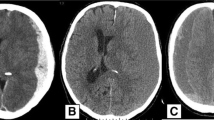Abstract
Comparative analysis of subdural hematomas (SDH) with or without injuries of the cerebral matter. A total of 166 fatal head injuries caused by blunt force (BHI) between 1987–1997 were examined by the author, beginning with a careful removal of the brain during autopsy with special attention to the superficial blood vessels. In most cases the examination of the brain was carried out after formalin fixation. The cases were classified according to the major injury patterns of:
type 1: contusion of the cerebral cortex without extracerebral space-occupying hematoma (51)
type 2: contusions or lacerations of the cerebral cortex with space-occupying subdural hematoma (SDH; 42)
type 3: only SDH (no contusions of the brain; 30)
type 4: epidural hematoma (6)
type 5: coma and brain pressure in cases of minor macroscopic injury (13)
type 6: injuries of the posterior cranial fossa (10)
The remaining 14 cases exhibited rare injury patterns. In BHI with a clear cause and direction of the injury (example: fall from a standing position), the incidence of SDH depended on the direction of the impact. SDH occurred in 12 out of 38 cases with an occipital, in 12 out of 17 cases with a lateral and in 4 out of 5 cases with a frontal impact. Based on the injury type, the ratio of occipital impact/all other localizations was 33/18 in type 1, 18/24 in type 2 and 2/28 in type 3. In ca. 40% of the 72 SDH cases observed, SDH was the single intracranial result of the trauma. Cases with only SDH (type 3) clearly differed from SDH combined with injuries of the cerebral matter (type 2), including the circumstances of the injury, the presence of skull fractures (yes/no: type 2: 39/3, type 3: 2/28), the frequency of hospital admissions and trepanations, as well as the number of chronic alcoholics. 28 out of 42 cases of type 2, but only 11 of 30 cases of pure SDH, were due to „unsuspicious“ falls. Batteries were undoubtedly responsible for 5/42 cases in type 2 (all falls caused by blows) and 8/30 in type 3. No clear differentiation could be made between accident and beating in 11 out of 30 cases in type 3 and in only 1 case in type 2. Pure SDH is particularly problematic to assess because it often involves a combination of dubious circumstances, suspicious external injuries, but no valid evidence from the findings alone to reconstruct the type of the violent event. In view of clinical reports on the existence of spontaneous SDH, a particularly careful and extensive examination should be untertaken in these cases to reliably answer the question of a traumatic genesis.
Zusammenfassung Fragestellung:
Vergleichsanalyse von Subduralhämatomen (SDH) mit bzw. ohne weitere Schädel-Hirnverletzungen. Methode, Untersuchungsgut: 166 tödliche stumpfe Schädel-Hirn-Traumen (SHT) 1987–1997; ein Untersucher. Im Material enthalten waren 42 SDH bei starken Hirnkontusionen und 30 isolierte SDH. Resultate: Bei SHT mit eindeutiger Ursache und Verletzungsrichtung (Beispiel: Stürze aus dem Stand) hing die Häufigkeit eines SDH von der Richtung der Gewalteinwirkung ab: bei occipitalem Aufschlag lag in 12 von 38 Fällen ein SDH vor, bei lateralem in 12 von 17 und bei frontalem in 4 von 5 Fällen. Fälle mit isoliertem SDH unterschieden sich deutlich von den mit Hirnverletzungen kombinierten SDH, u.a. durch die Verletzungsumstände, das Vorliegen von Schädelfrakturen, die Häufigkeit noch erfolgter Klinikeinlieferungen und Trepanationen sowie den Anteil chronischer Alkoholiker. Aufgrund von Befunden und Umständen her „unverdächtige“ Sturzereignisse lagen 28 von 42 Fällen bei SDH mit Kontusion, aber nur 11 von 30 bei isoliertem SDH zugrunde; bei Fremdeinwirkungen waren dies 5/42 bzw. 8/30 Fälle; nicht zwischen Unfall und Fremdeinwirkung zu unterscheiden war bei der ersten Gruppe nur ein Fall, beim isolierten SDH waren es 11 von 30. Schlussfolgerung: Das „isolierte SDH“ ist gutachtlich oft besonders problematisch, da hier häufig folgende Faktoren kombiniert sind: dubiose Umstände, verdächtige Verletzungen, aber keine vom Befund her allein beweiskräftige Rekonstruktion der Art der Einwirkung möglich. In diesen Fällen ist ein besonders vorsichtiges und aufwendiges präparatorisches Vorgehen bereits von der Entnahme des Gehirnes an notwendig, um über den Nachweis der Blutungsquelle die Frage nach einer tatsächlich traumatischen Genese zuverlässig beantworten zu können.
Similar content being viewed by others
Author information
Authors and Affiliations
Additional information
Eingegangen: 4. Mai 1998 / Angenommen: 25. Juni 1998
Rights and permissions
About this article
Cite this article
Maxeiner, H. Entstehungsbedingungen, Quellen und Typologie von tödlichen Subduralblutungen. Rechtsmedizin 9, 14–20 (1998). https://doi.org/10.1007/s001940050071
Issue Date:
DOI: https://doi.org/10.1007/s001940050071




